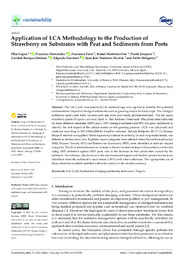Please use this identifier to cite or link to this item:
https://hdl.handle.net/11000/36679Full metadata record
| DC Field | Value | Language |
|---|---|---|
| dc.contributor.author | Legua, Pilar | - |
| dc.contributor.author | Hernández, Francisca | - |
| dc.contributor.author | Tozzi, Francesca | - |
| dc.contributor.author | Martínez Font, Rafael | - |
| dc.contributor.author | Jorquera, David | - |
| dc.contributor.author | Rosique Jiménez, Caridad | - |
| dc.contributor.author | GIORDANI, EDGARDO | - |
| dc.contributor.author | Martinez Nicolas, Juan Jose | - |
| dc.contributor.author | Melgarejo Moreno, Pablo | - |
| dc.contributor.other | Departamentos de la UMH::Producción Vegetal y Microbiología | es_ES |
| dc.date.accessioned | 2025-05-23T12:34:50Z | - |
| dc.date.available | 2025-05-23T12:34:50Z | - |
| dc.date.created | 2021-06-02 | - |
| dc.identifier.citation | Sustainability 2021, 13(11), 6323 | es_ES |
| dc.identifier.issn | 2071-1050 | - |
| dc.identifier.uri | https://hdl.handle.net/11000/36679 | - |
| dc.description.abstract | The Life Cycle Assessment (LCA) methodology was applied to identify the potential environmental impact of dredged sediments used as growing media for food crops. The dredged sediments used came from Livorno port and were previously phytoremediated. For the assay, strawberry plants (Fragaria x ananassa Duch vr. ‘San Andreas’) were used. The plants were cultivated on three different substrates (100% peat, 100% dredged sediment and 50% mix peat/sediment) to identify the real impact of the culture media on the growing process. LCA was calculated and analyzed according to ISO 14040:2006 by SimaPro software. ReCipe Midpoint (E) V1.13/Europe Recipe E method was applied. One kilogram of produced strawberry, for each crop media tested, was defined as the functional unit. Eighteen impact categories were selected where Marine Eutrophication (ME), Human Toxicity (HT) and Freshwater Ecotoxicity (FET) were identified as relevant impact categories. The LCA results showed an increase in the environmental impact of strawberry cultivation using 100% sediment against 100% peat, due to the decrease in fruit production caused by the sediment. Nevertheless, the decrease in the environmental impact and the fruit production increase identified when the sediment is used mixed (<50%) with other substrates. The appropriate use of these substrates would be justified within the context of the circular economy | es_ES |
| dc.format | application/pdf | es_ES |
| dc.format.extent | 12 | es_ES |
| dc.language.iso | eng | es_ES |
| dc.publisher | MDPI | es_ES |
| dc.rights | info:eu-repo/semantics/openAccess | es_ES |
| dc.rights | Attribution-NonCommercial-NoDerivatives 4.0 Internacional | * |
| dc.rights.uri | http://creativecommons.org/licenses/by-nc-nd/4.0/ | * |
| dc.subject | Life Cycle Assessment | es_ES |
| dc.subject | Dredging sediments | es_ES |
| dc.subject | Techno-soil | es_ES |
| dc.subject | Fragaria | es_ES |
| dc.title | Application of LCA Methodology to the Production of Strawberry on Substrates with Peat and Sediments from Ports | es_ES |
| dc.type | info:eu-repo/semantics/article | es_ES |
| dc.relation.publisherversion | https://doi.org/10.3390/su13116323 | es_ES |

View/Open:
sustainability-13-06323-v3.pdf
1,23 MB
Adobe PDF
Share:
.png)
